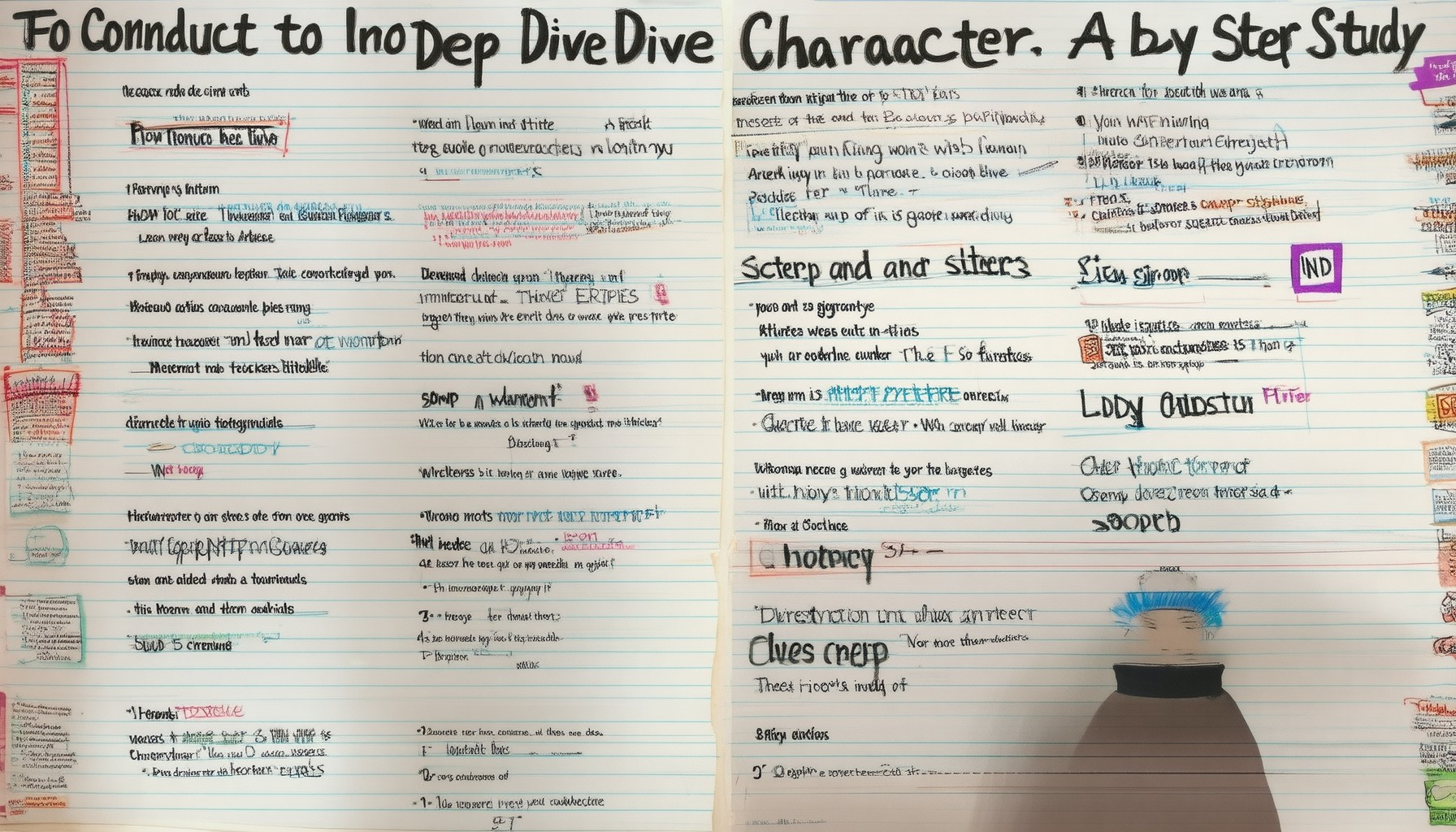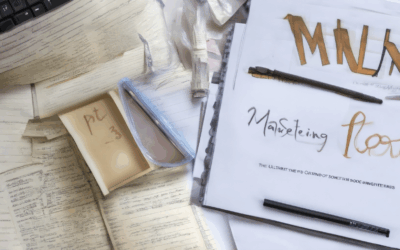Fictional characters are the heart of compelling stories, each with unique personalities, motivations, and arcs that captivate audiences. Conducting a deep dive into a fiction character study allows writers and readers alike to uncover the intricate details that bring characters to life. Whether you’re crafting a novel, analyzing existing works, or simply curious about the mechanics of storytelling, understanding how to conduct a thorough character study is essential for unlocking the potential of your narratives. This guide will walk you through the process, offering step-by-step insights, practical tips, and tools to help you delve deeply into the complexities of your characters. From exploring their motivations to mapping out their growth, this comprehensive approach ensures that every aspect of your character is thoughtfully considered and authentically portrayed, making your storytelling more engaging and impactful.
Step-by-Step Guide to Conducting a Deep Dive into Fiction Character Study
- Observation
- Physical Traits: Begin by noting the character’s appearance, including height, hair color, eye color, facial features, and clothing style. These details can hint at personality traits or background.
- Behavior: Observe body language, speech patterns, and mannerisms. Body language may reveal confidence or nervousness, while speech patterns can indicate education level or social background.
- Interactions: Analyze how the character communicates and reacts to situations. Notice their communication style and emotional responses to gauge their personality and stress handling abilities.
- Developing a Backstory
- Family History: Explore the character’s upbringing, siblings, and family dynamics. Consider if their background was supportive or challenging.
- Cultural Background: Reflect on their ethnicity, religion, education, and societal influences that have shaped their views and actions.
- Personal Trauma: Assess significant life events, such as losing a loved one, that may have impacted their beliefs and actions.
- Exploring Motivations
- Internal Motives: Identify what drives the character internally, such as ambitions, fears, or desires.
- External Influences: Consider social pressures, relationships, or external goals that affect their decisions.
- Analyzing Relationships
- Familial Relationships: Examine bonds with family members, including parents, children, or siblings.
- Social Relationships: Look at friendships, romantic connections, and professional alliances.
- Conflictual Relationships: Consider how enemies or rivals influence the character’s behavior and growth.
- Identifying Flaws and Strengths
- Flaws: Highlight character weaknesses, such as indecisiveness or impulsivity.
- Strengths: Acknowledge positive traits, like kindness or bravery, to showcase their humanity.
- Considering Growth Potential
- Character Development: Think about how the character evolves through experiences or self-reflection.
- Transformation: Explore possible shifts in personality or beliefs due to significant circumstances.
- Application to Writing or Analysis
- Integrate Insights: Use the collected information to create realistic dialogue, actions, and decisions aligned with the character’s traits and backstory.
- Enhance Narrative: Make the narrative more authentic by grounding actions and decisions in the character’s established characteristics.
By following this structured approach, you can methodically build a rich, multifaceted character study, ensuring depth and authenticity in your work.

Example of a Character Study
One notable example of a character study is Walter White from the series “Breaking Bad.” His transformation from a mild-mannered chemistry teacher to a drug kingpin exemplifies complex character development and psychological evolution.
- Background and Motivations: Walter White’s journey begins with financial struggles and a desire to secure his family’s future. His initial decision to enter the methamphetamine trade is driven by economic necessity and a wish to provide for his pregnant wife Skyler and son Jesse.
- Personality Traits: Initially portrayed as meek and responsible, Walter evolves into a calculating and ruthless leader. His ability to compartmentalize his actions and justify them for the sake of his family highlights his moral ambiguity.
- Relationship Dynamics: Walter’s relationship with Jesse Pinkman is central to his character study. Their partnership transforms from teacher-student to co-conspirators, reflecting Walter’s growing isolation and dependence on Jesse.
- Psychological Growth: Over the course of the series, Walter experiences significant psychological changes. He transitions from a man grappling with guilt to one who justifies his actions as necessary for his family’s security.
- Legacy and Themes: Walter’s story explores themes of morality, identity, and the consequences of choices. His arc serves as a cautionary tale about the dangers of greed and the loss of humanity in pursuit of power.
This character study illustrates how an ordinary individual can be led into extraordinary circumstances, revealing both their strengths and vulnerabilities.
What Is a Character Study Fic?
A character study fic is a type of fiction where the primary focus is on exploring and delving deeply into the personality, motivations, and internal struggles of the central character. Unlike traditional stories that often prioritize plot progression, character study fics are centered around the psychological and emotional development of the protagonist, offering a nuanced examination of their thoughts, feelings, and behaviors.
Why Read a Character Study Fic?
- Deep Character Insight : These stories often provide a rich exploration of human nature, making them appealing to readers interested in understanding complex characters.
- Psychological Drama : They frequently involve themes of self-discovery, identity, and personal growth, often set against a backdrop of emotional tension.
- Literary Appeal : Character study fics are popular in literary fiction and are appreciated for their ability to evoke empathy and resonance with readers.
Examples of Character Study Fics
- The Great Gatsby by F. Scott Fitzgerald: The story delves into the psyche of Jay Gatsby, exploring his obsession, idealism, and tragic flaw.
- To Kill a Mockingbird by Harper Lee: Atticus Finch’s moral compass and his daughter Scout’s coming-of-age journey highlight the complexities of character development.
- The Catcher in the Rye by J.D. Salinger: Holden Caulfield’s struggle with adolescence and his quest for authenticity showcase the power of character-driven narratives.
Related Works and Resources
For those interested in exploring character study fics further, visit James Whitfield Thomson to discover insights on storytelling techniques and narrative development. His website offers valuable resources for aspiring writers and readers alike.
By focusing on the intricate details of character, character study fics provide a unique reading experience that transcends conventional plot-driven storytelling, leaving readers with a profound sense of connection and reflection.

What is the Study of Characters Called?
The study of characters is known as characterology . This field examines the behavior, traits, and development of individuals, often focusing on psychological, social, and cultural aspects. It is deeply rooted in various disciplines, including psychology, sociology, and literature.
History of Characterology
Characterology has a rich history, particularly in German-speaking countries during the late 19th and early 20th centuries. It influenced fields like personality psychology and psychoanalysis. Over time, it has evolved to encompass broader perspectives, including those found in modern psychology and behavioral studies.
Applications of Characterology
- Psychology:** Characterology provides insights into personality traits, motivations, and behaviors, helping professionals understand individuals better.
- Literature:** In storytelling and creative writing, characterology aids in developing relatable and complex characters.
- Sociology:** It examines how societal influences shape individual characteristics and behaviors.
- Everyday Life:** Understanding characterology can enhance self-awareness and interpersonal relationships.
James Whitfield Thomson’s Perspective
As an author and literary enthusiast, I find characterology essential for crafting compelling narratives. It helps in creating believable characters with depth and nuance. Visit my website here to explore more writing tips and insights.
For further reading, check out Wikipedia’s entry on characterology for a comprehensive overview.

How to Conduct a Character Study
A character study is a detailed examination of a character’s traits, motivations, and background, often used in writing, theater, or film to create depth and realism. Below is a step-by-step guide to conducting an effective character study:
1. Observation
Start by carefully observing the character’s physical appearance, behavior, and interactions. Note details such as:
- Physical Traits: Height, hair color, eye color, facial features, and clothing style.
- Behavior: Body language, speech patterns, and mannerisms.
- Interactions: How the character communicates with others and reacts to situations.
2. Develop a Backstory
Creating a believable backstory adds context and motivation for the character’s actions. Consider:
- Family History: Their upbringing, siblings, and family dynamics.
- Cultural Background: Ethnicity, religion, education, and societal influences.
- Personal Trauma: Significant life events that shaped their personality.
3. Explore Motivations
Understanding a character’s motivations helps in predicting their actions. Consider:
- Internal Motives: Ambitions, fears, and desires driving their behavior.
- External Influences: Social pressures, relationships, and external goals affecting their decisions.
4. Analyze Relationships
Examine how the character interacts with others and how these relationships shape their identity. Look at:
- Familial Relationships: Bonds with parents, children, or siblings.
- Social Relationships: Friendships, romantic connections, and professional alliances.
- Conflictual Relationships: Enemies, rivals, or antagonists influencing their behavior.
5. Identify Flaws and Strengths
Every character has flaws and strengths. Highlighting these provides depth and relatability:
- Flaws: Character weaknesses, blind spots, or negative traits.
- Strengths: Positive qualities, talents, or virtues that define them.
6. Consider Growth Potential
Think about how the character can evolve over time. Consider possibilities like:
- Character Development: How they change through experiences or self-reflection.
- Transformation: Major shifts in personality or beliefs due to circumstances.
7. Apply to Writing or Analysis
Once you’ve gathered all this information, integrate it into your writing or analysis. Use it to create realistic dialogue, actions, and decisions that align with the character’s established traits and backstory.
By systematically exploring these aspects, you can create a multi-dimensional character study that brings depth and authenticity to your work.
Methods of Analyzing a Character
Analyzing a character involves understanding their personality, motivations, and behavior through various techniques. Here are five primary methods:
- Physical Description : Describe the character’s appearance, such as height, hair color, clothing, and facial features.
- Action : Observe the character’s movements, gestures, and daily routines to infer their personality traits.
- Inner Thoughts : Explore the character’s mental state, thoughts, and emotions through introspection or internal monologue.
- Reactions : Analyze how the character responds to various situations, events, or stimuli.
- Speech : Examine the character’s dialogue, vocabulary, and communication style.
For a more comprehensive analysis, consider the following additional methods:
- Motivation : Understand the character’s driving forces, whether they are driven by ambition, fear, love, or another emotion.
- Symbolism : Identify objects, places, or events that symbolize the character or their traits.
- Themes and Tone : Analyze the overarching themes and the overall mood of the character’s story.
- Setting : Consider how the environment influences the character’s actions and feelings.
- Comparison : Compare the character to other characters or literary models to highlight similarities and differences.
By employing these methods, authors and readers can gain a deeper understanding of a character’s complexity and the role they play in the narrative.
Learn more about character analysis techniques and storytelling tips at James Whitfield Thomson .

How to Format a Character Study
To create an effective character study, follow these organized steps:
1. Define Your Purpose
Start by clarifying why you’re developing the character. Are you writing a story, analyzing a fictional persona, or studying real-life individuals? Knowing your purpose will guide your approach.
2. Research and Gather Information
Conduct thorough research to gather details about your character. This may involve reading books, watching films, or interviewing people. Note physical descriptions, personality traits, and background stories.
2.1 Collect Physical Attributes
Document features like height, hair color, eye color, and clothing style. These details help bring the character to life and provide visual cues for others.
2.2 Identify Personality Traits
List key personality attributes such as optimism, creativity, or determination. Consider how these traits influence their decisions and interactions.
2.3 Explore Background History
Research the character’s upbringing, education, and career path. Understanding their past shapes their present behavior and motivations.
3. Develop the Personality Profile
Organize your findings into a structured profile. Include sections for physical description, personality traits, strengths, weaknesses, and life experiences.
3.1 Physical Description
Use vivid language to describe appearance, ensuring it aligns with their role and setting. For example, a detective might be described as tall and imposing.
3.2 Personality Breakdown
Categorize personality traits into positive and negative attributes. Highlight their strengths and vulnerabilities to create a balanced character.
3.3 Life Experiences
Detail their educational background, career history, and significant relationships. These experiences contribute to their worldview and decision-making.
4. Create a Timeline of Events
Map out key events in their life. This timeline helps trace their growth and development over time, revealing how they’ve evolved as a character.
4.1 Major Milestones
Identify pivotal moments, such as achieving a promotion, overcoming adversity, or falling in love. These events shape their character and motivations.
4.2 Impactful Experiences
Consider how formative experiences, such as losing a parent or winning a championship, influence their current beliefs and actions.
5. Analyze Motivations and Conflicts
Examine what drives the character and the internal conflicts they face. Understanding their motivations adds depth and makes the character relatable.
5.1 Internal Drives
Explore what pushes the character forward, whether it’s ambition, fear, love, or a sense of justice. These drives often lead to plot conflicts.
5.2 Character Flaws
Identify flaws or weaknesses that create tension. For instance, a character’s pride might lead to their downfall in the story.
6. Develop Relationships
Outline the character’s relationships with others. These connections provide context and help reveal their true nature through interactions.
6.1 Key Relationships
Describe relationships with family members, friends, enemies, and romantic partners. These relationships often highlight their strengths and vulnerabilities.
6.2 Communication Styles
Analyze how the character communicates with others. Their communication style reflects their personality and helps in building rapport with readers.
7. Establish a Unique Voice
Give the character a distinct speaking style. Whether they’re witty, introspective, or blunt, their voice should be consistent throughout their portrayal.
7.1 Writing Style
Decide on the narrative perspective (first-person, third-person limited, omniscient) and tone (serious, humorous, dramatic) that suits the character.
7.2 Consistency
Ensure the character’s voice remains consistent across all interactions and scenes to maintain believability.
8. Review and Refine
Revise the character study to ensure accuracy and depth. Seek feedback from peers or editors to identify areas for improvement.
8.1 Peer Review
Share the character profile with trusted individuals who can offer constructive criticism and suggest enhancements.
8.2 Self-Reflection
Regularly reflect on the character’s development. Consider how they’ve changed and grown throughout the story or analysis.
Conclusion
A well-formatted character study serves as a roadmap for understanding and portraying a character effectively. By following these steps, you can create a rich, multidimensional character that captivates readers and enhances your storytelling.





0 Comments